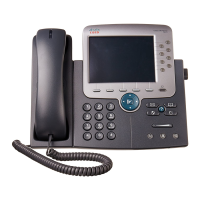9-19
Cisco Unified IP Phone 7975G Administration Guide for Cisco Unified Communications Manager 6.0
OL-12642-01
Chapter 9 Troubleshooting and Maintenance
Monitoring the Voice Quality of Calls
A Conceal Ratio of zero indicates that the IP network is delivering frames and packets on time with no
loss.
Troubleshooting Tips
When you observe significant and persistent changes to metrics, use Table 9-5 for general
troubleshooting information:
Table 9-5 Changes to Voice Quality Metrics
Metric Change Condition
MOS LQK scores
decrease significantly
Network impairment from packet loss or high jitter:
• Average MOS LQK decreases could indicate
widespread and uniform impairment.
• Individual MOS LQK decreases indicate bursty
impairment.
Cross-check with Conceal Ratio and Conceal
Seconds for evidence of packet loss and jitter.
MOS LQK scores
decrease significantly
• Check to see if the phone is using a different
codec than expected (RxType and TxType).
• Check to see if the MOS LQK version changed
after a firmware upgrade.
Conceal Ratio and
Conceal Seconds
increase significantly
• Network impairment from packet loss or high
jitter.
Conceal Ratio is near or
at zero, but the voice
quality is poor.
• Noise or distortion in the audio channel such as
echo or audio levels.
• Tandem calls that undergo multiple
encode/decode such as calls to a cellular
network or calling card network.
• Acoustic problems coming from a
speakerphone, handsfree cellular phone or
wireless headset.
Check packet transmit (TxCnt) and packet receive
(RxCnt) counters to verify that voice packets are
flowing.
Note Voice quality metrics do not account for noise or distortion, only frame loss.

